This is a solo play through of the Live Free Or Die American War of Indepence rules from Little Wars TV. The rules writers have produced some useful introductory videos and support materials on the Little Wars website . They have also put together a really informative series on their audio podcast (search Little Wars on your podcast provider) which gives an insight into a number of the key design decisions. Also there is a Facebook group, though I haven’t had a chance to participate much yet.
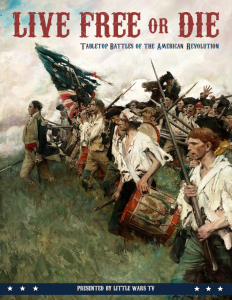
In short, this is a set of rules that is inspired by Andy Callan’s Loose Files and American Scramble (published 1987!). However it is a ruleset in it’s own right and is much more than just Loose Files 2.0. The authors started off trying to produce a game that captured the period and was simple, elegant, fast moving and explainable to non-wargamers.
My first impressions are that it does give a great feel of the war. I have a number of minor quibbles and possibly I have misunderstood some of the rules. This blog post will just summarise how I played through my game and my thoughts on the rules as they happened at the time (which could well be misplaced!). My intention is to post separately my thoughts on the rules once I have researched a bit more and checked through and rethought some of my assumptions.
All figures are 10mm Pendraken Miniatures
Initial Setup
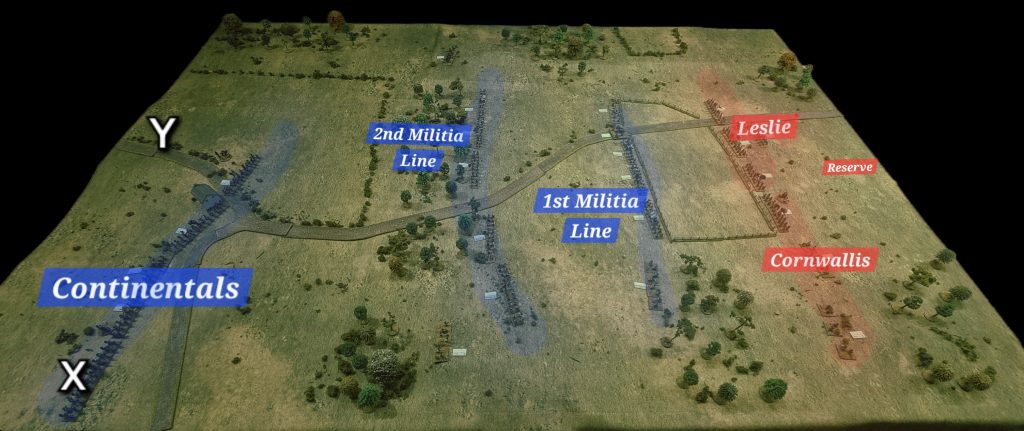
This scenario is available in the download pack produced by Little Wars TV as a supplement for the rules, also available from their website.
Cornwallis commanding the British must inflict more American casualties than he takes himself to achieve a minor victory, but a major victory needs him to take the road exits at X or Y. The game is set at 10 turns in lengthy (finishing at 6pm game time).
The American commander, Greene must prevent this happening. I chose for Green to deploy approximately historically with two lines of militia and the Continentals securing the back line.
The British force is heavily outnumbered but has many elite battalions (1st or 2nd class in the rules terminology). The Americans rely heavily on large numbers of 4th class militia, though the Continentals (2nd & 3rd class) should be able to go toe-to-toe with the British.
I decided that Cornwallis would just try to bludgeon his way through the militia to get to the Continentals (similar to real life!)
Turn 1
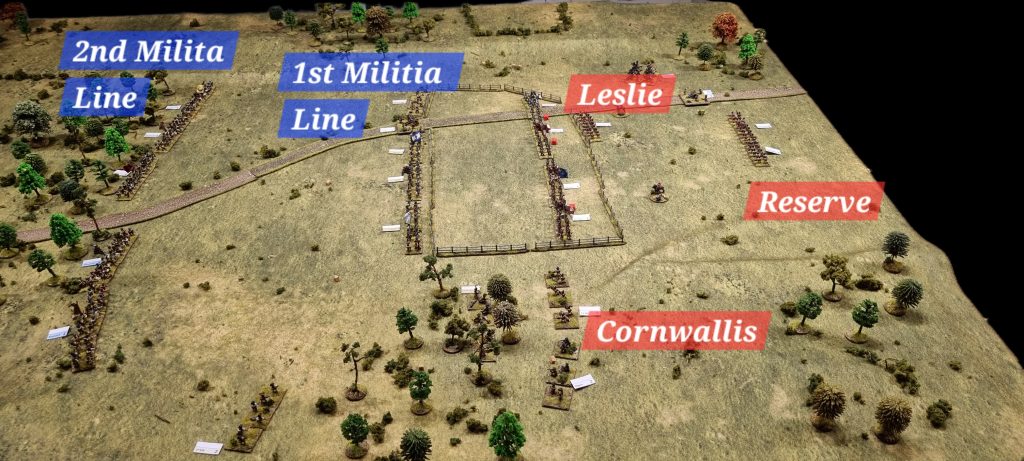
The Americans win initiative and roll more command points (Command points are based on leader quality with some variable rolls. They allow the player to initiate charges, move units/brigades and rally disruption).
However, it is Turn 1 and doesn’t really matter. The Americans are standing defensively while the British are advancing in cohesion. The first line of British regiments cross the rail fence and pick up some disorder. They can’t rally it off because of proximity to American first line. The British reserves arrive on table.
Disorder in the rules is measured in DMZ points. This was originally known as DP in the Loose Files rules. I’m British and the phrase DMZee brings me out in hives. For this post I”ll call it DMZ but just remember I’m pronouncing it DMZed !! Anyways, DMZs accrue throughout the game and will eventually mean casualties and some reduction in melee effectiveness.
Turn 2 will be more interesting…… the British are in bayonet charge range now
Turn 2
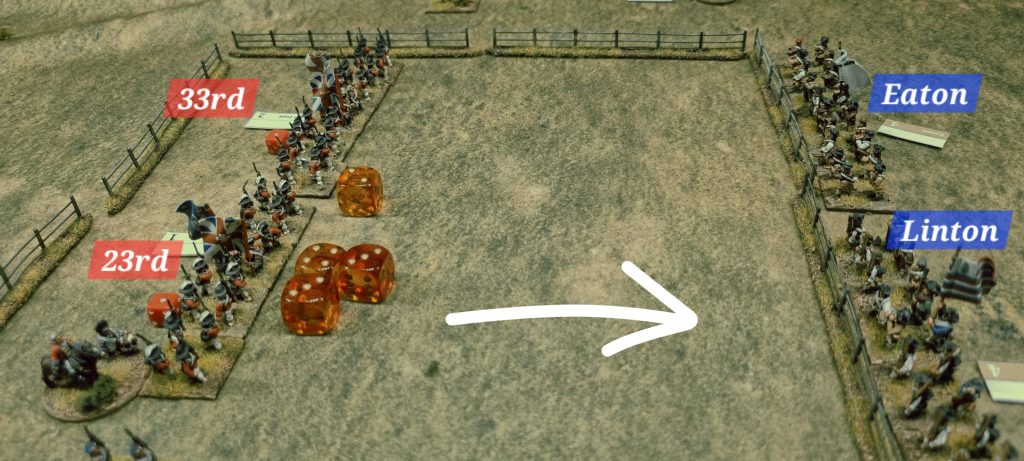
Viewed from the British right, Allocating command points. (the orange dice are me keeping track of the CPs, ignore the numbers, I’m just using dice as markers)
It’s really expensive in CPs to launch a charge, especially a bayonet charge. This is something I’m not entirely sure is right but playing rules-as-written for this one. The Brits decide to bayonet charge (with Cornwallis leading in the front rank ) with the 23rd and ten move forward everyone else. In this game you do Charges, then Firing and then Movement…,,,,
The American militia fire closing shots and inflict 2 disruption points on the 23rd – which is good shooting and will be significant
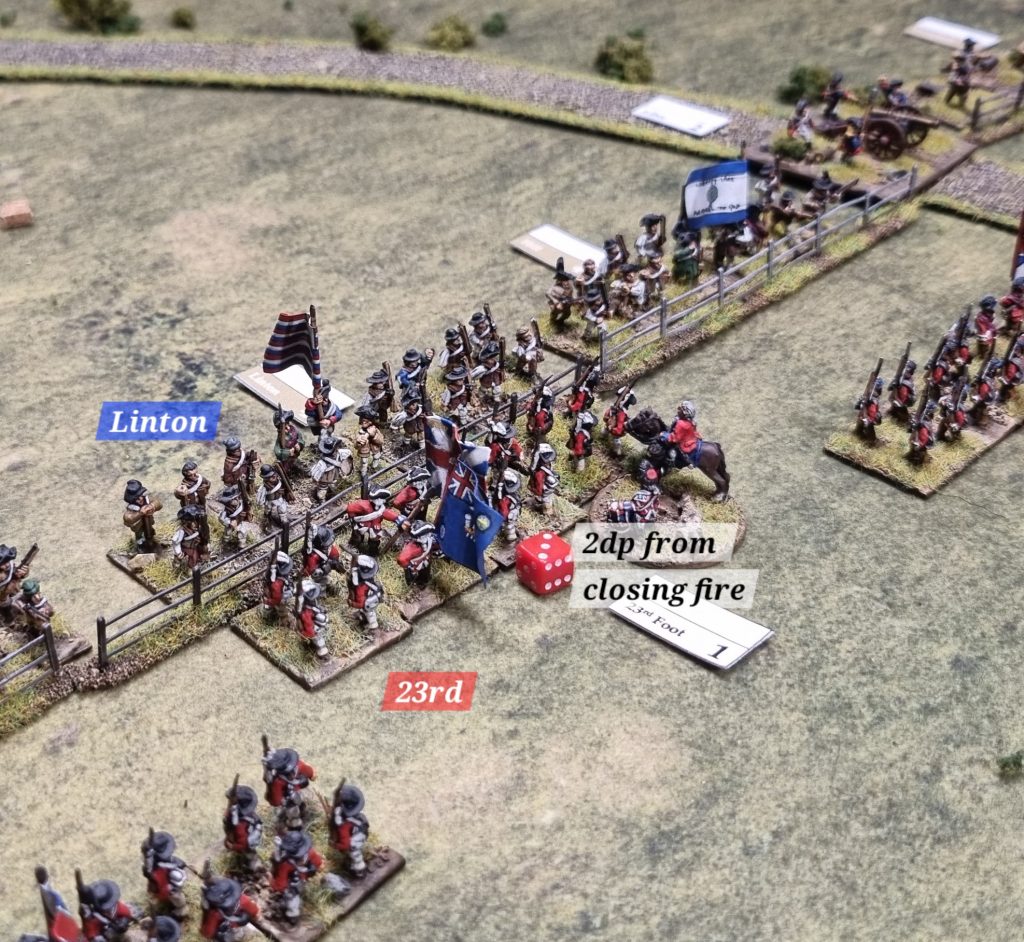
In melee it’s now the Brits on 16 dice vs Americans on 3 dice, needing 5+ (Almost everything in this game requires a roll of 5+ on a D6. This gives a pleasantly elegant consistency to the mechanisms).
British rolling is poor : 4 hits vs 1 American. This means they force the militia to retreat losing a base and taking disruption. This sight also disrupts the militia unit to their right. However the 23rd take 2 DMZs as part of the combat (they only won by +3 not +4). Added to their existing 3 DMZs they now take a casualty, then fail a morale test (really shit rolling), and retreat making the 33rd take 3 DMZs and then to top it all, Cornwallis gets a flesh wound.
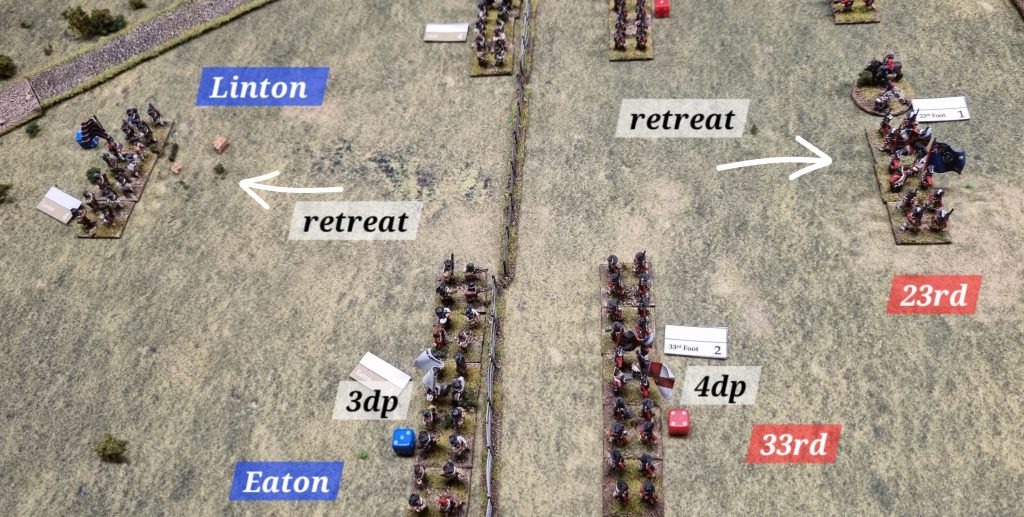
A slight rules oddity, 5 DMZ = remove a base. Which is ok, but then your DMZs reset to zero. I don’t really get this – why would you suddenly be restored to good order after 25% of your men have died/run away ? If DMZs were just wounds then yes, but I think they are meant to represent disruption and demoralisation too.
The militia that ran away are now out of 12″ of enemy so in theory could rally off a DMZ – except they are militia and need a leader to do this.
Turn 3
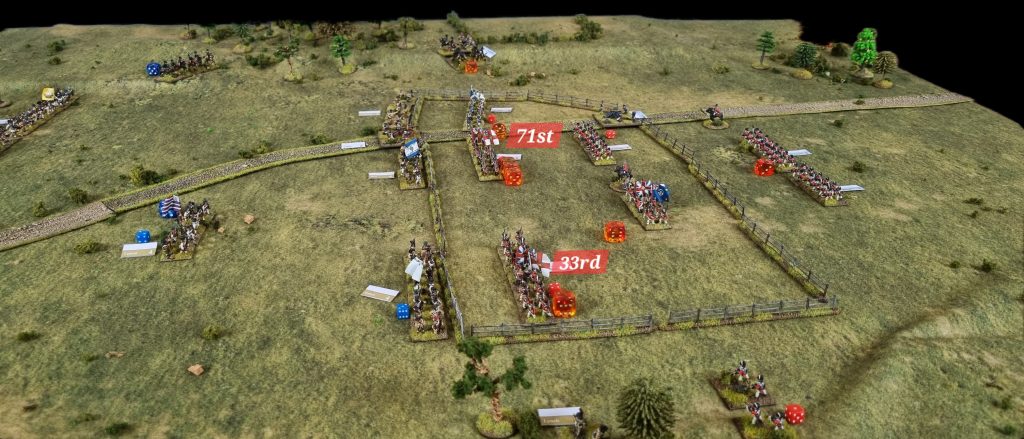
The British allocate command points. They have 8 to allocate this turn and it costs 4 to initiate a bayonet charge. Cornwallis decides to go in with the 71st. The 33rd have 4 DMZ, so having learned from last turn he will instead rally-off some of that and just engage in musketry. The British should be able to win a firefight because of the American militia’s difficult with regaining DMZ. Everywhere else the line moves forward. The Americans plan to hold firm and Greene is galloping forward to restore some morale – but he foolishly started at the back !
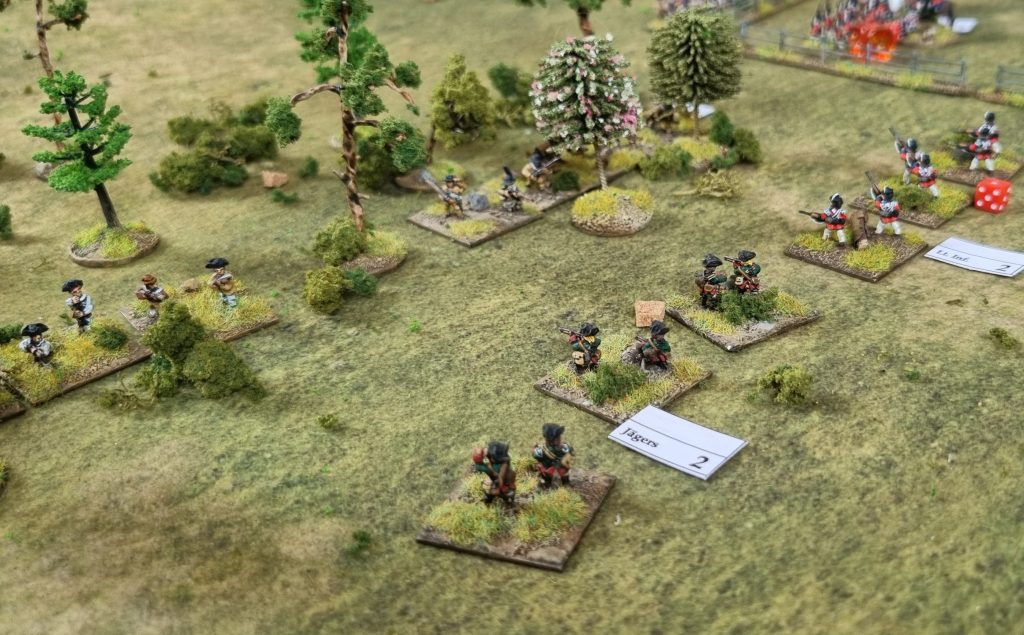
Cornwallis wanted to charge in with his Lights on the left flank and clear the American riflemen. But not enough CPs so he’ll just have to skirmish for now
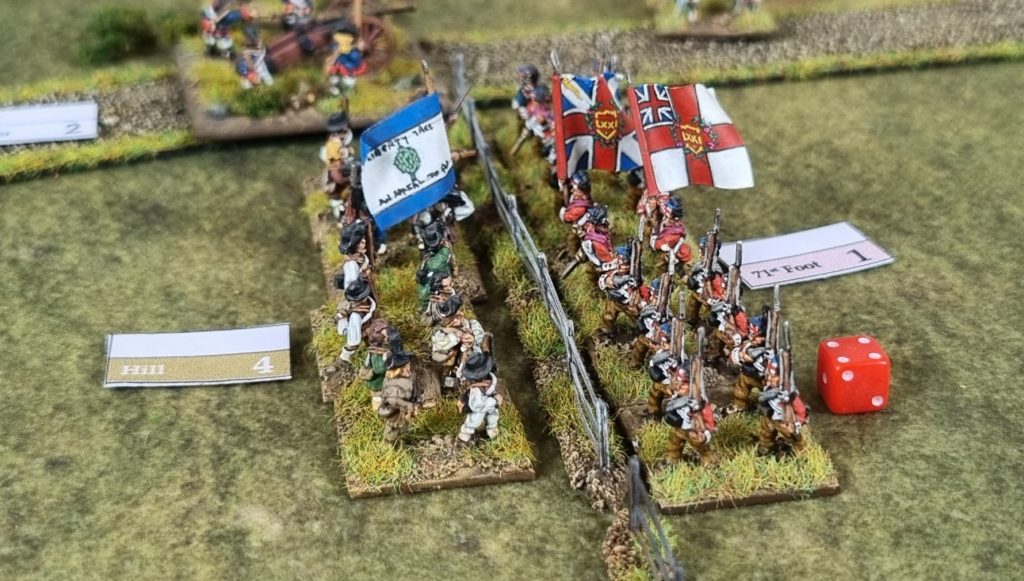
The 71st Highlanders charge in – but incredibly Hill’s militia score 3 hits from 4 dice on closing fire. Ouch !
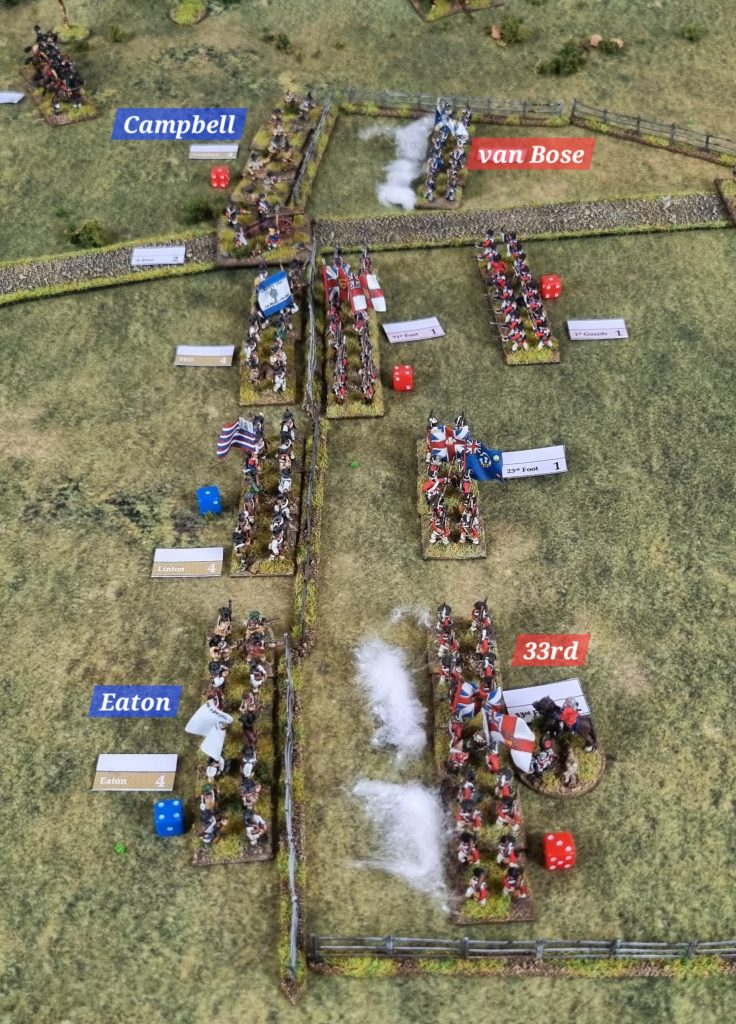
Some painful firing. On the British right, the van Bose Hessians take 3 hits from Campbell’s rifles – losing a base in the process but they pass their morale test. They reply with volley fire* but mostly aim high – only causing 1 hit back On the British left the 33rd unleash volley fire onto Eaton’s militia causing 6 hits from 10 shots. The militia lose a base and another 4 DMZ but amazingly pass their morale and stay in place
*Volley Fire is available to 3rd Class and better line infantry – you fire at double effect but can’t move (hence the smoke markers)

Now to resolve the melee. The 71st have 13 dice vs 3. Rolling isnt bad and they win 5-1. Hill’s militia retreat, lose 2 bases and accrue 2 DP. As they retreat the unit nearest must be hit with 3DMZ for panic. The 3pdr artillery is higher class so it cant be them – so Linton’s militia take the whack.
The 71st just take 1 DMZ but thats enough to remove a base (because of the effective closing fire). They pass their morale test, climb over the fence and pursue.
Here’s where the 4-page nature of the rules gets hazy. The 71st pursue a full move but it doesn’t mention terrain effects. So I’ve assumed they get a movement penalty for scaling the fence and 1DP as a result (The rail fences at Guilford had a material effect in real life so counting them as a minor obstacle in this. In other battles they probably wouldn’t impact )
Turn 4
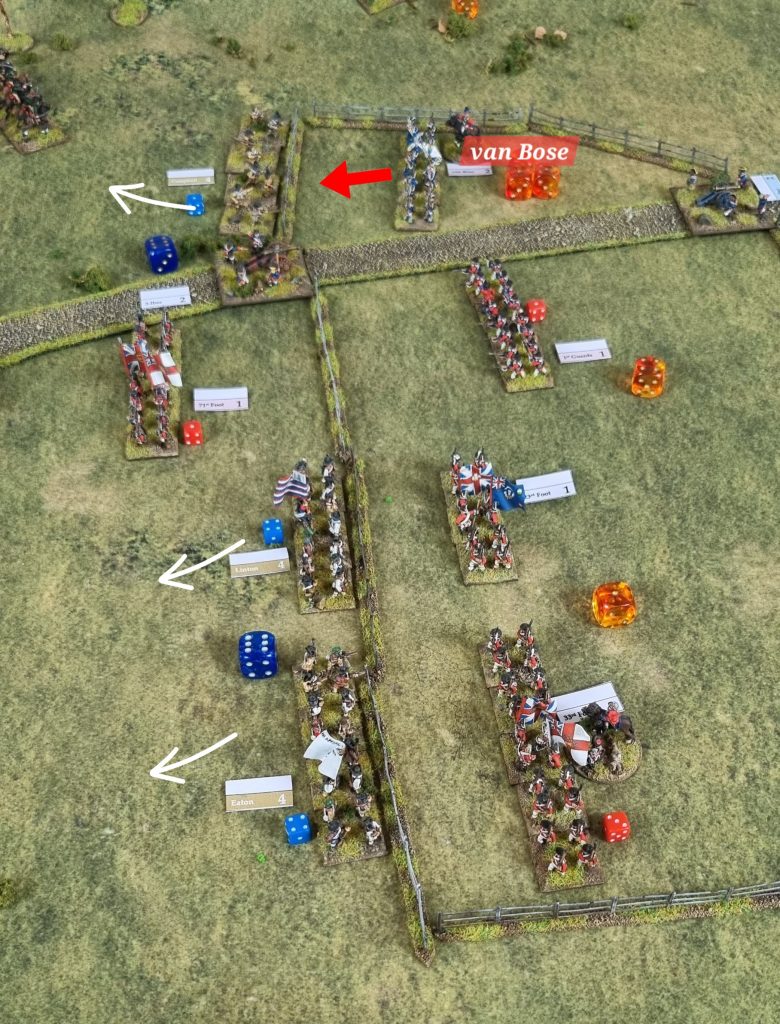
Greene decides to retire his front line. They’ve done decent work and losing a couple of bases in retreat is probably preferable to losing the whole line in combat The Brits decide to charge with van Bose to clear the riflemen (because shooting away skirmishers is difficult)
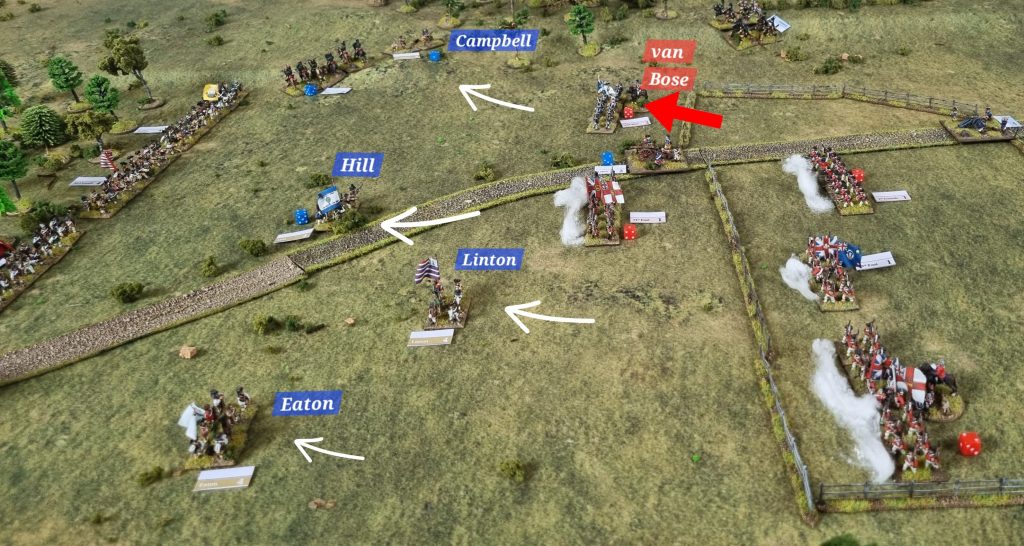
Relentless British volley firing and an effective charge by the Hessians leaves the first line devastated. Casualties are 10 American to 3 British bases – good going for the Brits in a way, but those 3 losses are all elites vs just American militia dead.
[There is an optional rule for skirmishers evading but played it straight here and they got mullered by Hessian bayonets]
For the first time in the game we get some redressing of ranks – The British reserve line is now far enough away from the enemy to restore some order
[One of the Command options open to a general is to join a unit to remove DMZs. This happens before charges – so they can get a unit sorted out and then go for it. In total though thats going to cost 5 CPs out of a total of possibly 7 or 8 – so its a big investment)
Turn 5
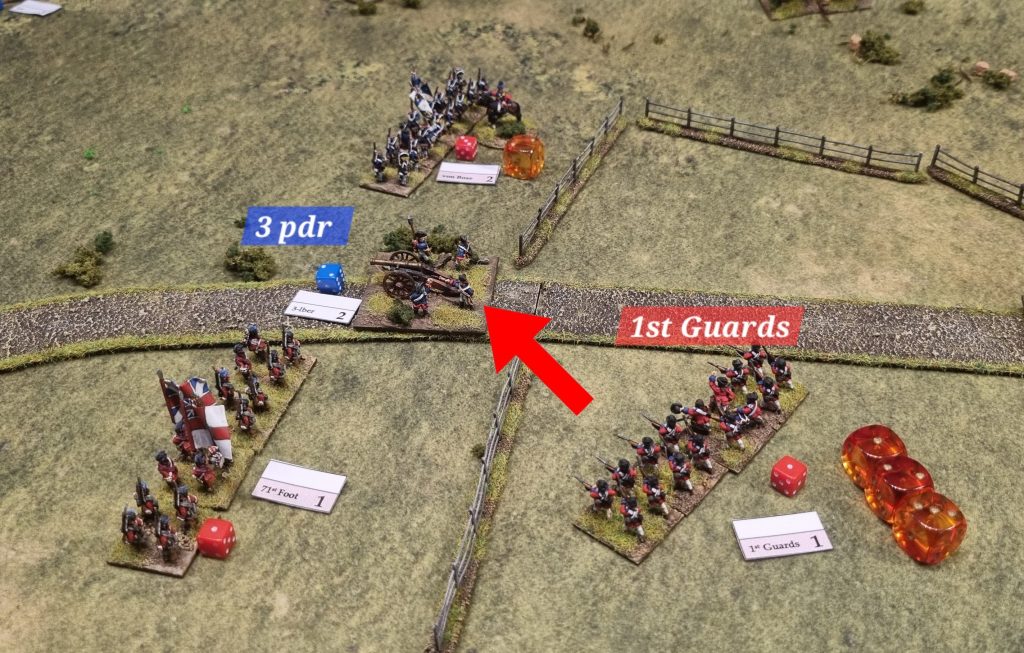
British CP roll is poor. Time just to consolidate along the line as the Americans do likewise. Just enough CP for the Guards to charge that limbered artillery that has somehow found itself in the middle of the British line
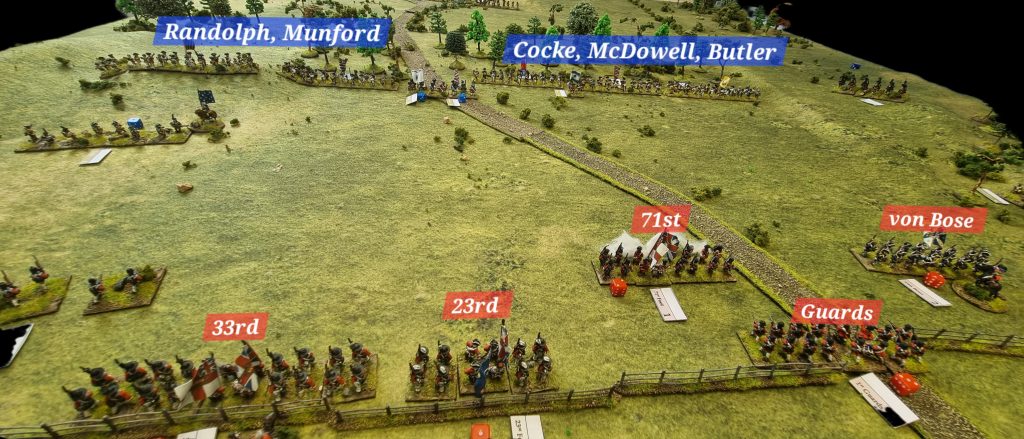
The Guards put the artillery out of their misery. It’s the end of Turn 5 – half way through the battle and it’s a long way for the British to capture the road exits they need to win a major victory
Turn 6
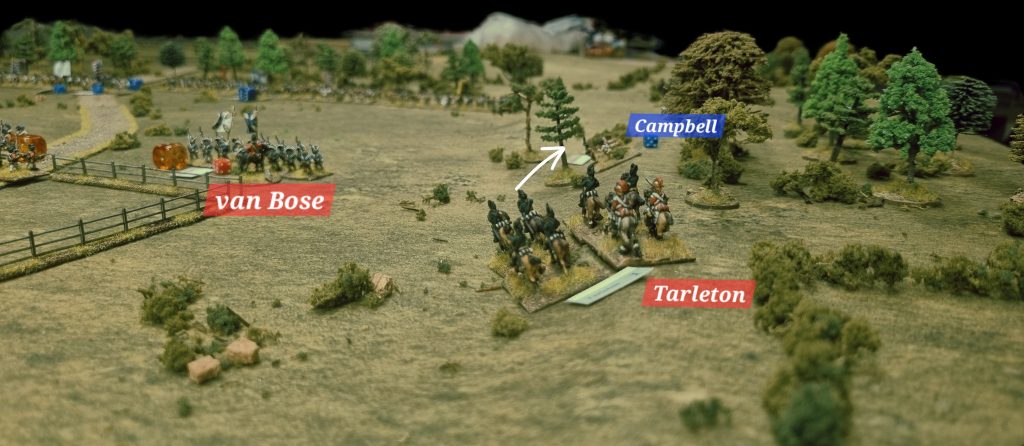
Another poor command point roll for the British but at this distance the line is just advancing anyway and the brigades have regained their cohesion. Worried about the van Bose Regt on the far right of the line getting enfiladed by Campbell’s militia riflemen, Tarleton elects to charge them with some loyalist steel
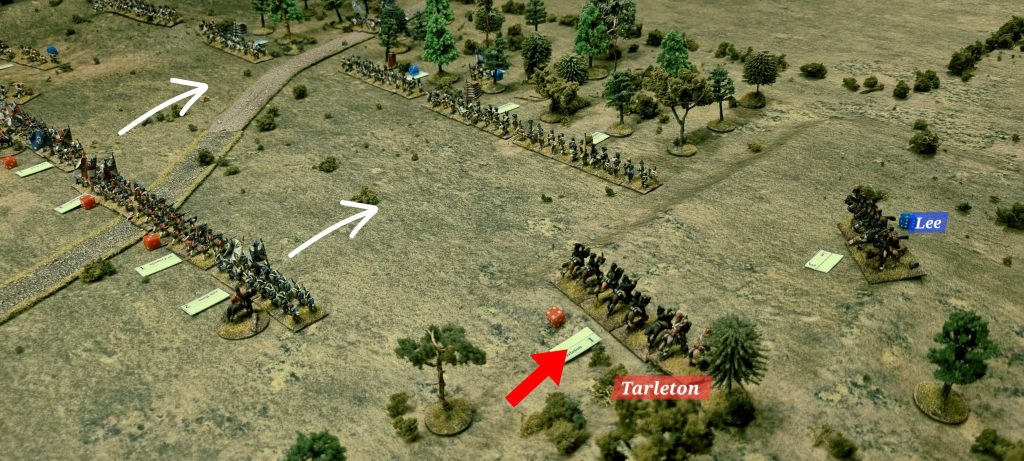
Tarleton crashes into the skirmishers who curse me for not allowing the evade rule. Tarleton’s British Legion has been rated 1st Class in this scenario. Seems a bit over-rated to me – but I guess these Yankee rule writers are still scared of him….(ducks for cover).
The cavalry win 7-0. The riflemen are destroyed. Being higher class troops, the Legion have an option not to pursue – but hey this is Tarleton so of course they do – they emerge from the woods to face down Lee’s Horse.
In the meantime the rest of the British line roll forward.
Turn 7
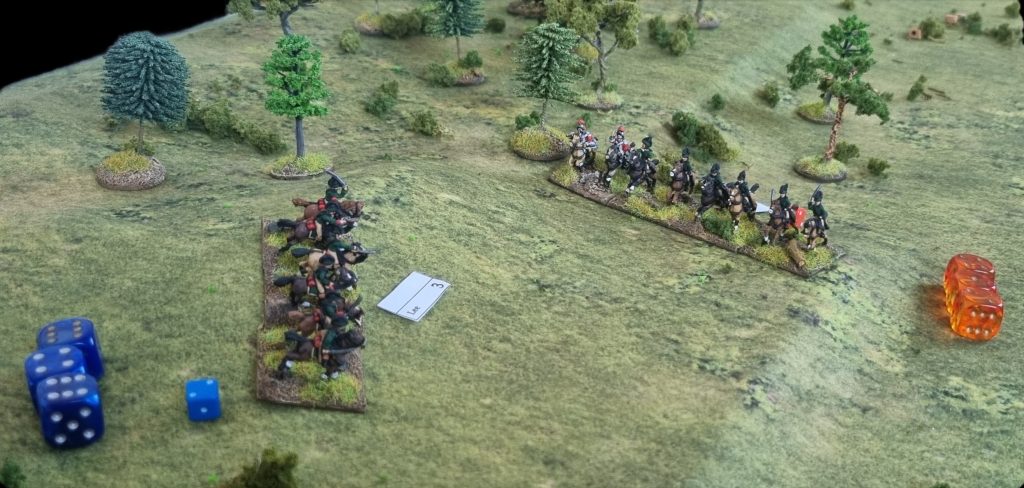
Trying out a tactical situation here. Lee’s horse are uphill of Tarleton but worse training class. The American general gives them enough command points for a charge – partly because it makes the British use up CP also to charge (winner of initiative gets the charge in first and therefore the charge bonus). Initiative is rolled after allocation of command points which makes this an interesting gamble. Allocation of 3 CP to this situation means the British main line can only advance this turn rather than try for some risky bayonet charges.
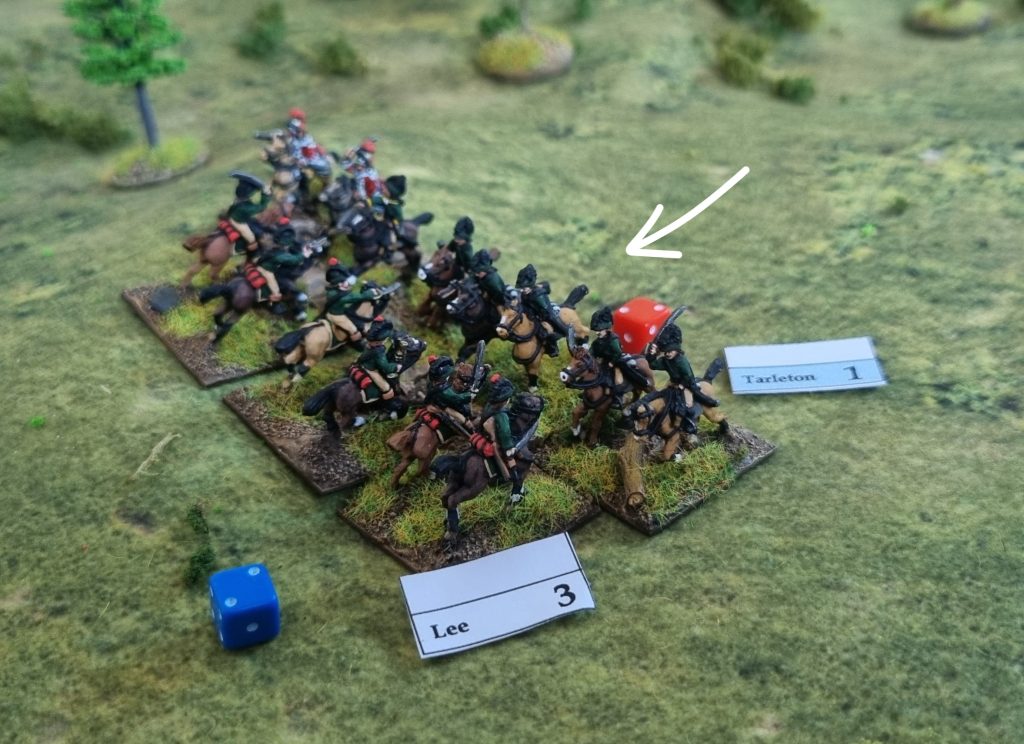
But for the first time in the game the British win initiative ! So Tarleton gets to charge into Lee before he can get his act together, and Bosh! Tarleton rides down Lee defeating him 4-0, killing 2 stands. He obviously pursues
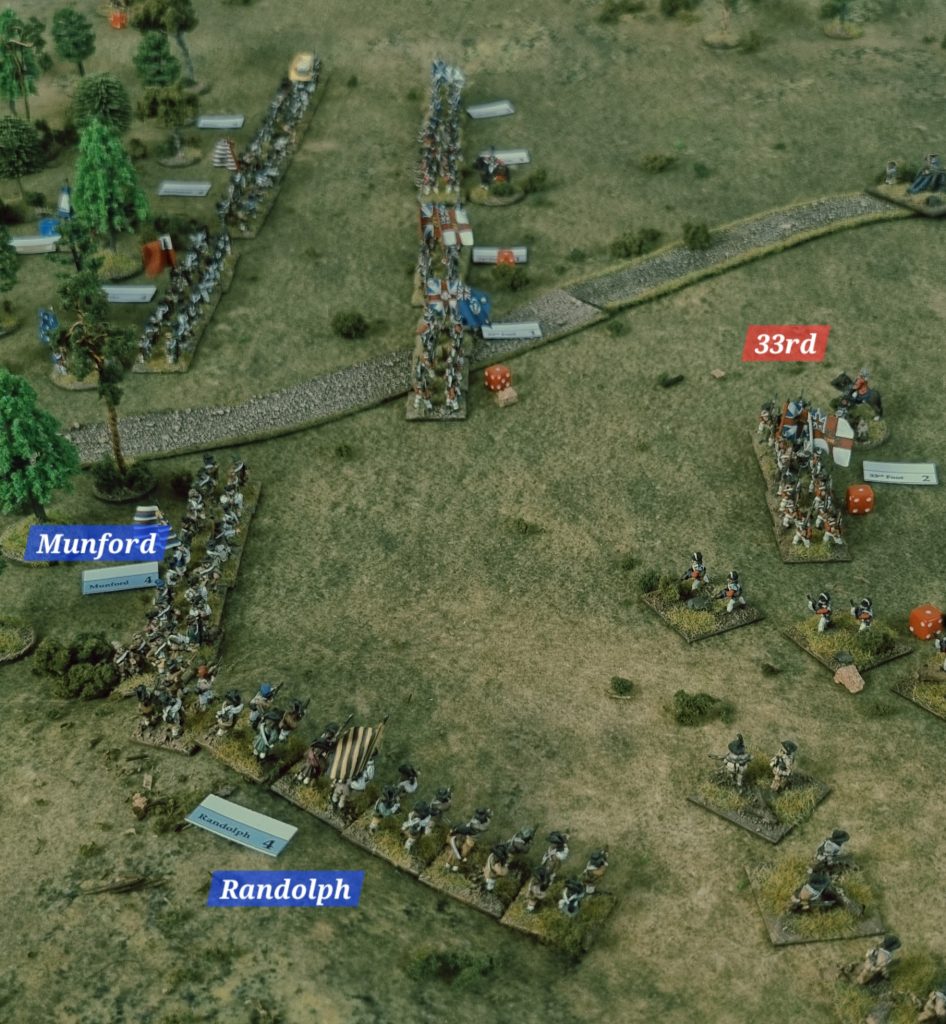
Meanwhile as the British advance into the centre ready to charge next turn. The 33rd hang back on their left flank – wary of the flanking trap that Randolph’s militia have set
Turn 8
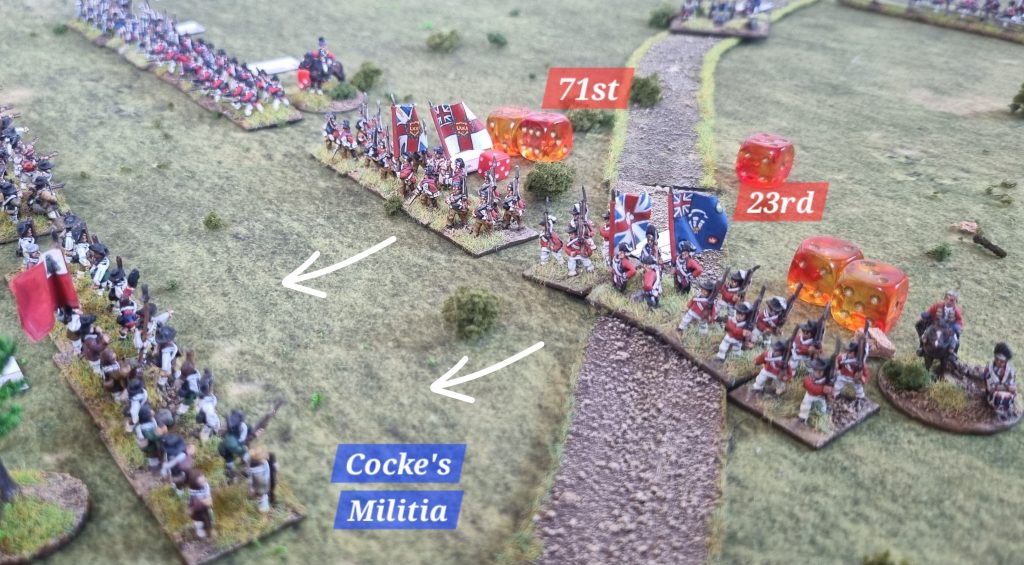
Cornwallis rolls poor command points again (The British start with a disadvantage, made worse by Cornwallis getting injured earlier and they keep rolling crap). Only 6 CP. Cornwallis wants to assault Cocke’s Militia with both the 23rd and the 71st Foot. But they are from different brigades so thats 2 CP to charge (thats normal charges not a Bayonet Charge which would be an extra CP) and 1 CP to move. For each regiment. Thats all the British are doing this go. Everyone else will just have to shoot.
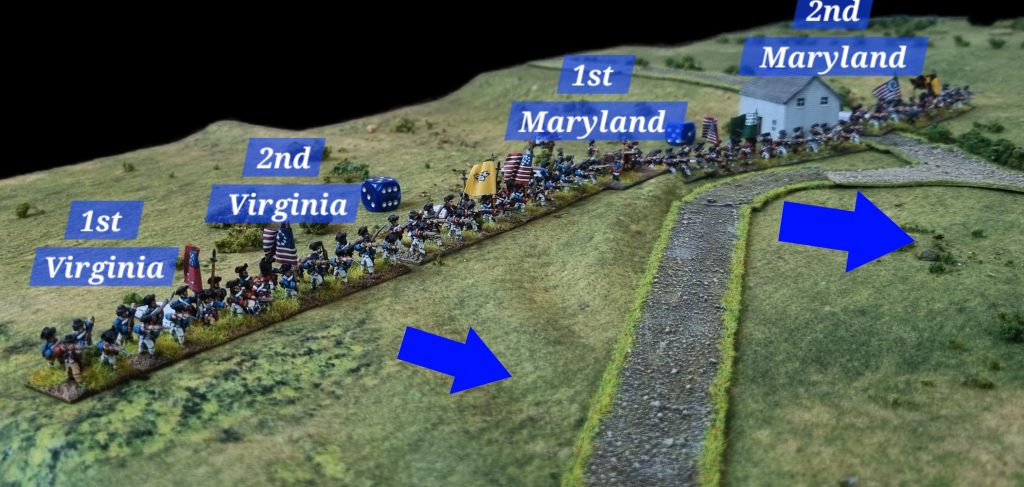
The Americans have more CP than they know what to do with. Predicting the second line will break soon and the risk of being flanked by cavalry, Huger moves the Continentals forward at last.
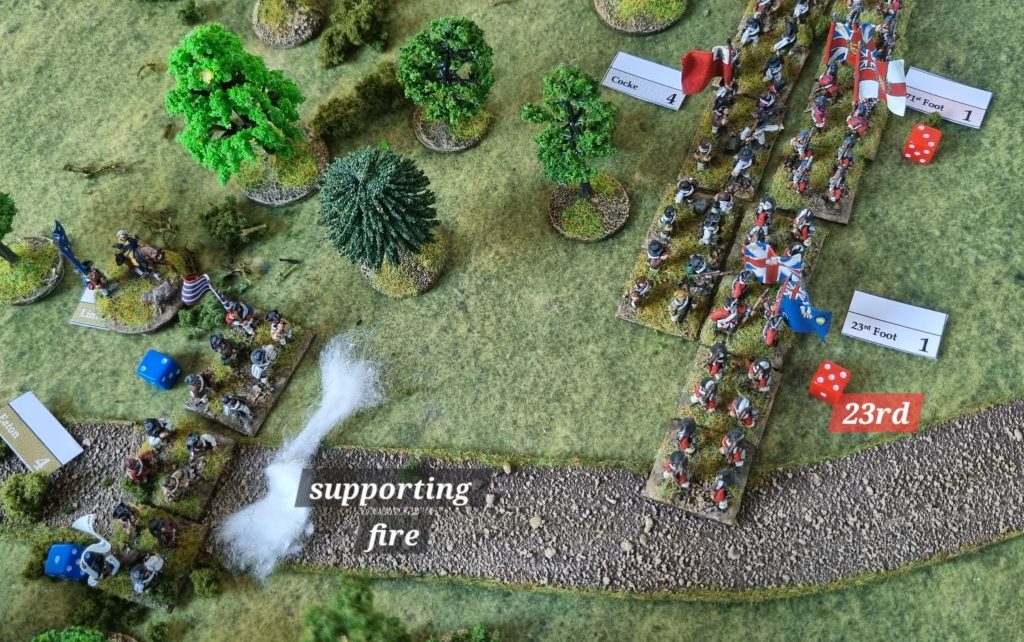
OK that didn’t go to plan. I realised I’d missed a rule – closing shots can include firing from any friendly unit with a firing arc to the chargers. The Americans get 5 dice vs the 23rd and hit with 4 of them. Killing a base. The 23rd are tough stuff though and pass their morale test
Now for the multi-unit melee of both the 23rd and 71st vs Cocke’s militia. This is the first time that the mechanics have felt a little clunky.
In a multi-unit melee you aggregate all the bases and then pick one unit that will drive the modifiers in combat and take all the casualties. The 23rd having lost a base during the charge are on 0 DMZ, so I chose them because they are elite and are most able to absorb the casualties. Its a simple mechanic with some game probability judgements but I’m not sure what it represents in real life.
Anyway the British, as usual roll appalling, dice and just recoil the militia instead of creaming them
Turn 9
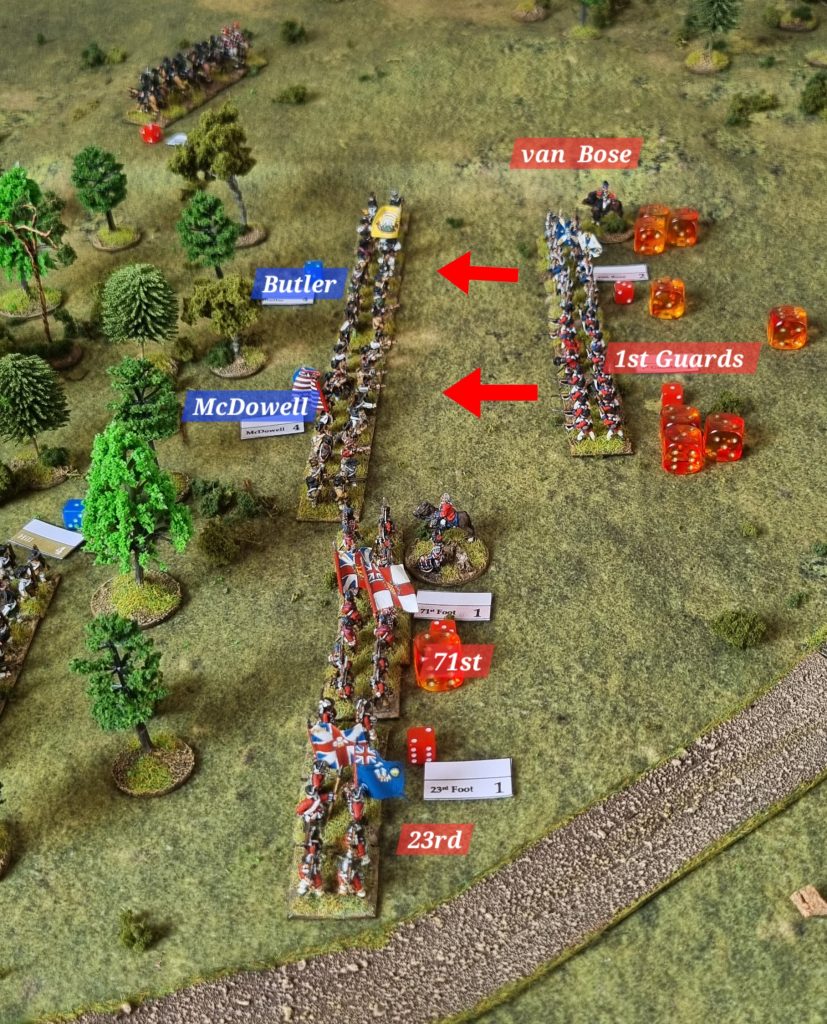
For once the British get a decent command point roll. They can initiate 2 bayonet charges. I’m still not convinced about how difficult it is to get a bayonet charge going ……. Leslie joins the van Bose to stiffen them up and then they will charge in along with the 1st Guards. Pretty much the last chance for Cornwallis
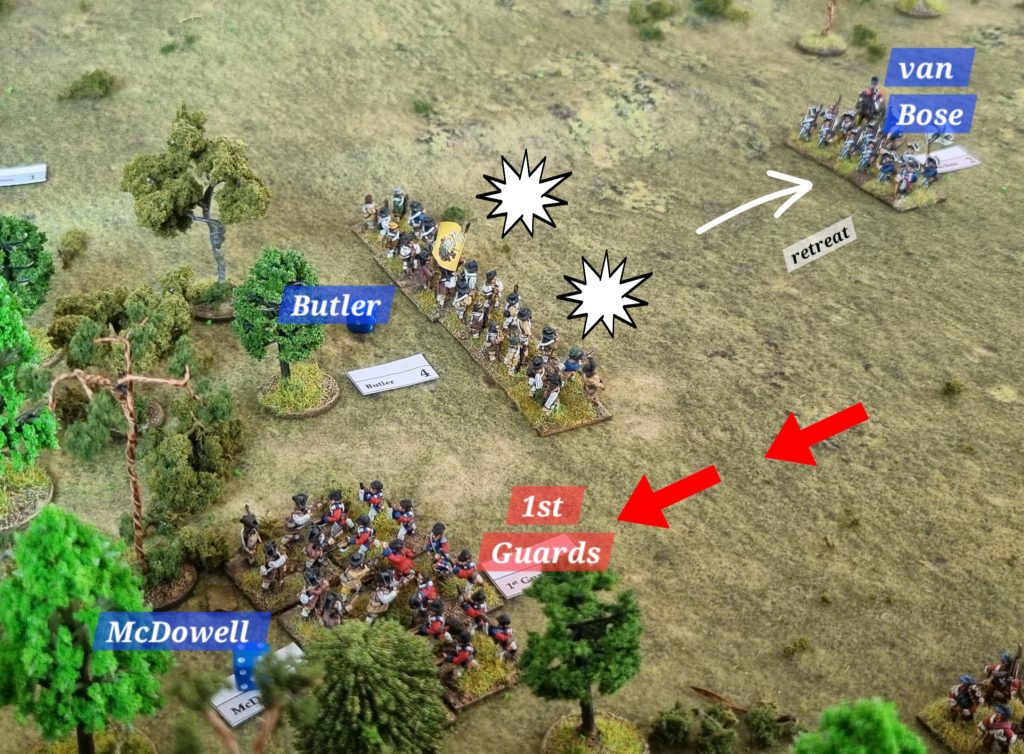
Mixed results for the British. Once again the American militia score spectular results on closing fire. The Hessians get hit 4 times (From 5 dice). So the Hessians lose a base and fail their morale test. Thankfully being only 2nd class troops they don’t cause the Guard to become disrupted. The Guards go in and rough up the militia beating them 4-0 and pursuing them into the woods – though they lose a base
Turn 10
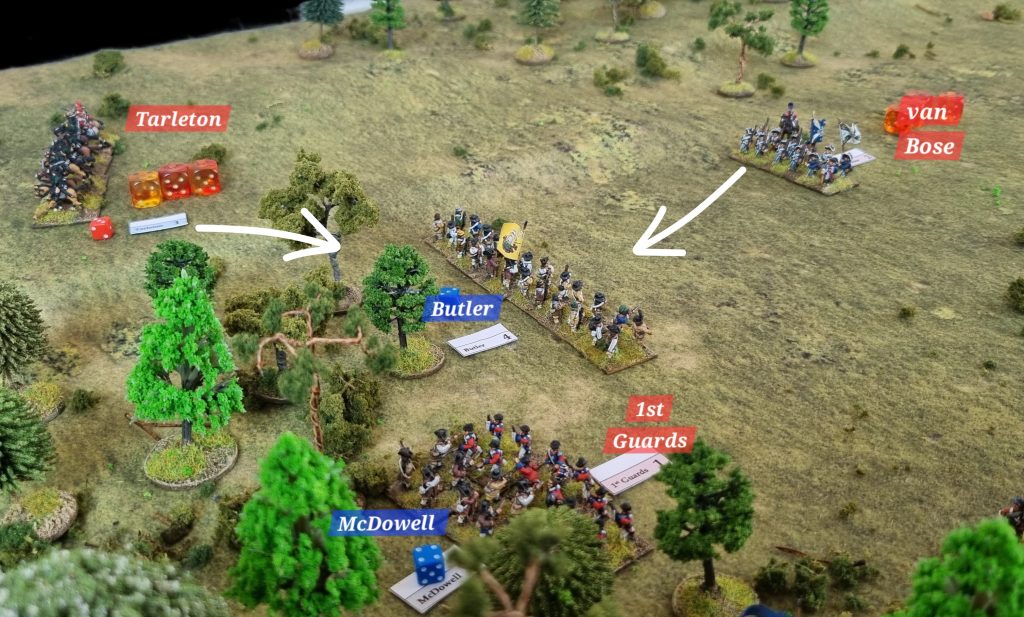
It’s the last turn, nearly 6pm. All Cornwallis can hope for now is to kill off some more militia. The 1st Guards will continue to bayonet McDowell’s militia in the woods. I’m assuming an ongoing combat doesn’t need an allocation of orders (The Guards maintained contact during their pursuit) and that a pursuit counts as a bayonet charge. The rules are don’t seem to cover this. Meanwhile Leslie is going to charge in with whats left of van Bose, while Tarleton gives Butler a surprise from behind
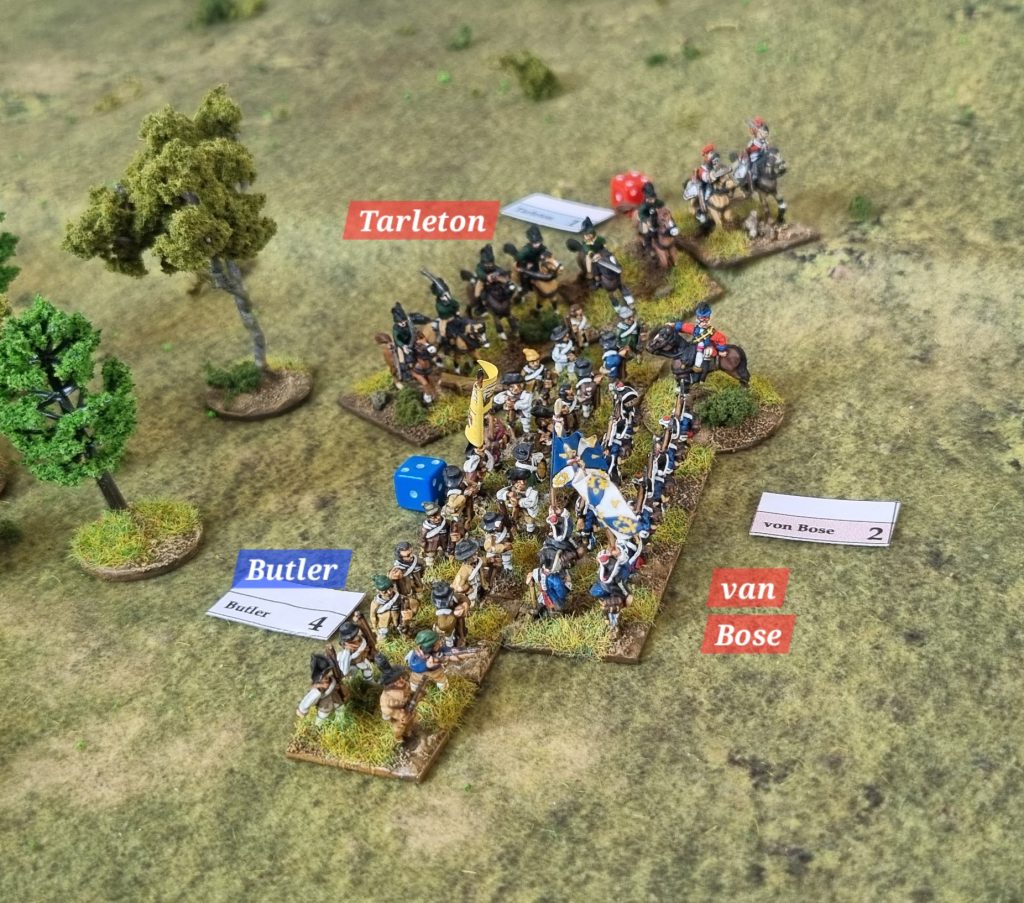
The multi-unit melee, again, ends up a bit gamey.
The British have to choose Tarleton or van Bose modifiers to fight the melee. After a bit of maths it’s van Bose who will take the casualties. An oddity about flank/rear charges is that they give no advantage in fighting a melee but they double the casualties. So it would be quite possible for a unit to be totally unphased by a rear charge. One to think about whether this is quite right…..
In the event Butler’s militia are mullered and take 4 bases and 8 DMZ. Added to their existing DMZ, thats total elimination. Which does make me think about the stickiness of units in this game. As far as I can tell a unit can lose 5 bases out 6 and be on 4DMZ and still be an effective unit. I know the designers wanted to model the tendency of units to retreat, rally and advance again. But I’m wondering whether there is a ‘break point’ type rule needed ?
Game Over
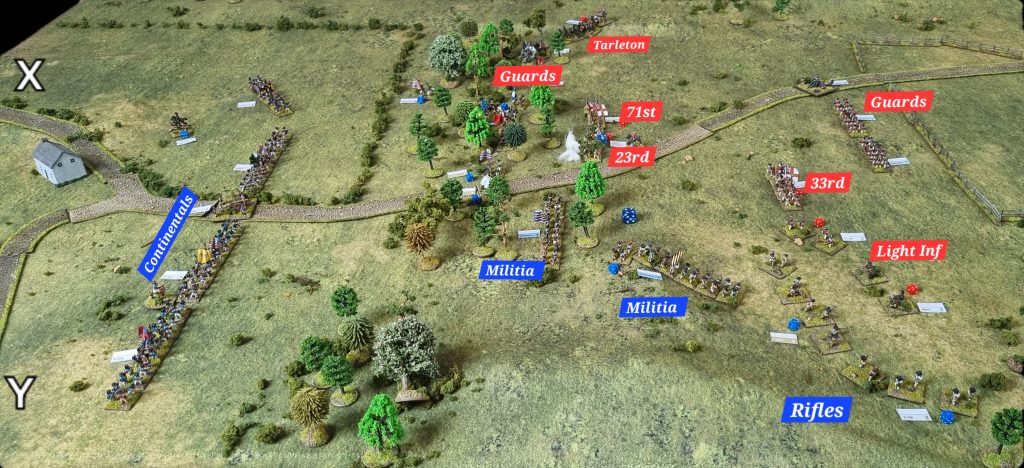
So that’s it.
The British are still a long way from their objective of capturing the exits at X or Y. They have a minor victory, having killed 27 American bases (1300 – 1900ish casualties and some artillery pieces) and only losing 8 bases themselves (400-600 casualties). But Greene will be happy to have lost replaceable militia while seeing Cornwallis’ elites further whittled down.
With another 5+ turns the British could feasibly threaten strongly down the right flank and push in their Guard reserves. But, 4 fresh, large battalions of Continentals who can hold their own in a fight would probably swing the decision.
Overall the result broadly felt right. Guilford Courthouse is a meatgrinder battle where it’s always tough for the British to achieve a major victory.
I’ve got a few (minor) quibbles with the rules and will research some clarifications but I’d definitely play this again and I already prefer it to other AWI rulesets that I have tried.
Wow! What a superb write up and pics… along with great painted figures and terrain. Really impressive and fun!
Thanks Michael!
That was a great write-up, thanks! I’ve been puttering with them solo as well, and I have the same reaction: overall very positive, but there a few gaps. Better than Black Powder, though I still have some affection for BG. Currently I’m working on refighting the ’45 in 3mm with LFoD, and so far I think it adapts really well. I should mention, too, that your figures and terrain were just excellent. I’d like to hear of any LFoD battles that you fight next! Best …. Mark
Cheers Mark! Using them for the 45 sounds interesting
Thanks for taking the time to write this up. Unless I’m missing something, it sounds like the rules are missing a trick in not using CP expenditure to encourage doctrinal difference. It surely shouldn’t be impossible for the British commander to launch more than two units in bayonet charges?
I’m also not a big fan of closing fire mechanics. Just feels like something that should be built into melee, but I know a lot of people like it.
I’m also not convinced on the bayonet charge mechanic for exactly the reasons you say.
In the original Loose Files, closing fire was represented as part of close combat in the way that you say. In practice i quite like the feeling of agency that it gives the defending player (even if this is just psychological)…
…However. When you consider that a charge is quite often just going to be 1 unit – the ability to do supporting closing fire means that it can be quite possibly overpowered. So,,,, overall its on my list of things to revise.
I think i’m going to play a game thats got a different dynamic -say Eutaw Springs to see what that plays like
Hi.
Excellent battle report.
Do you have a link or whatever to the Solo rules please.
I have looked in the Files section of the main site but can’t see anything.
Thank you.